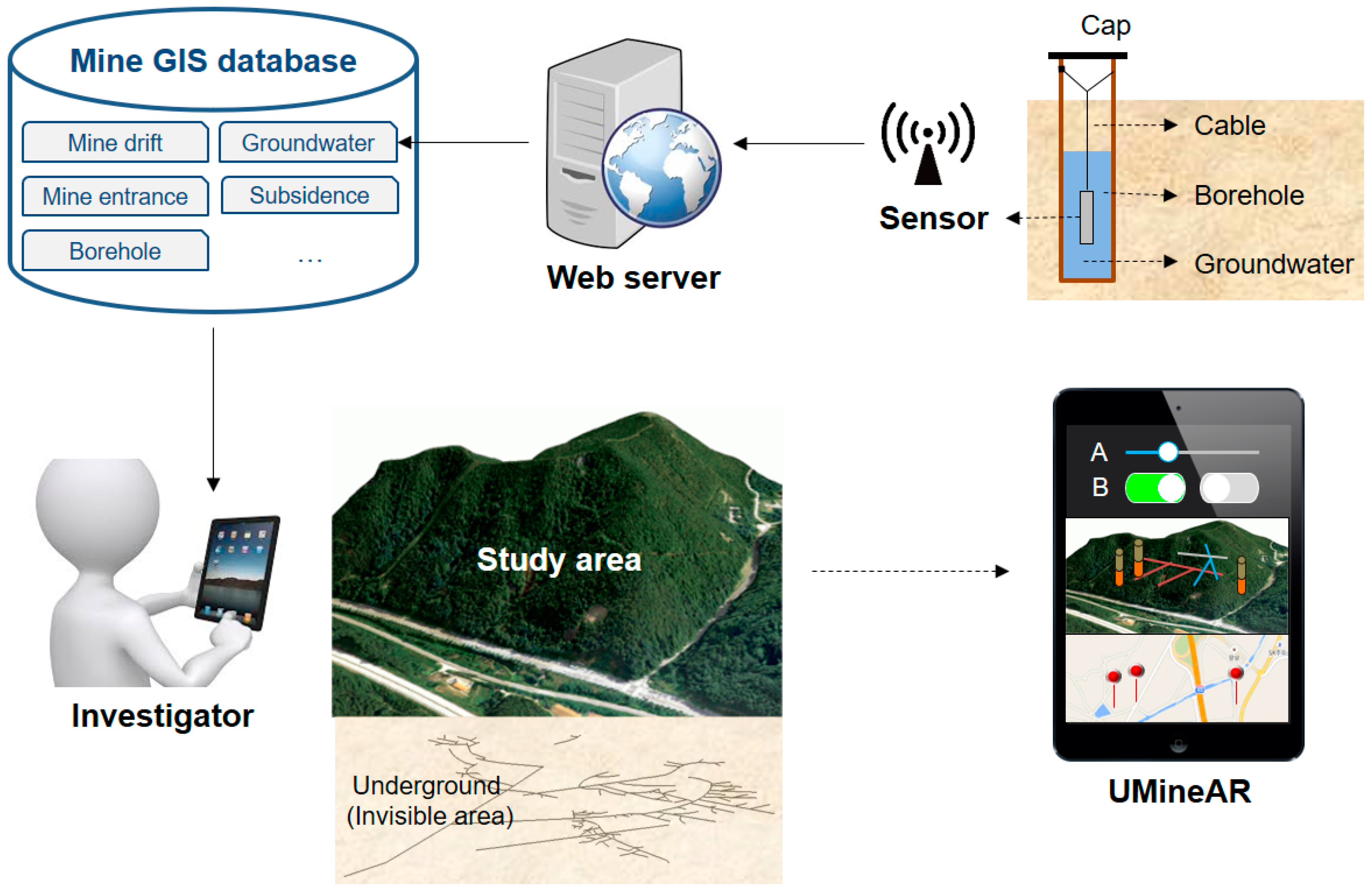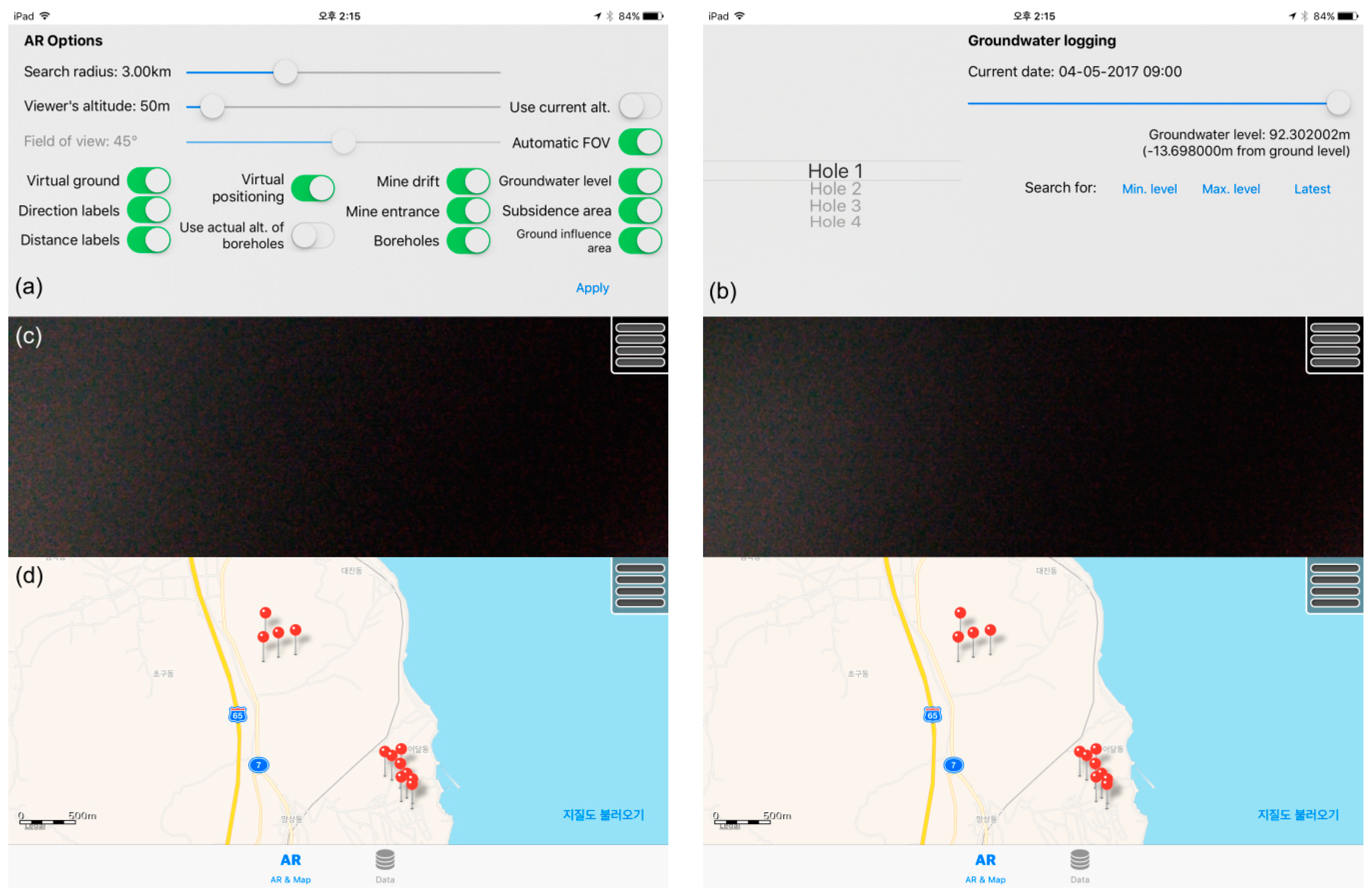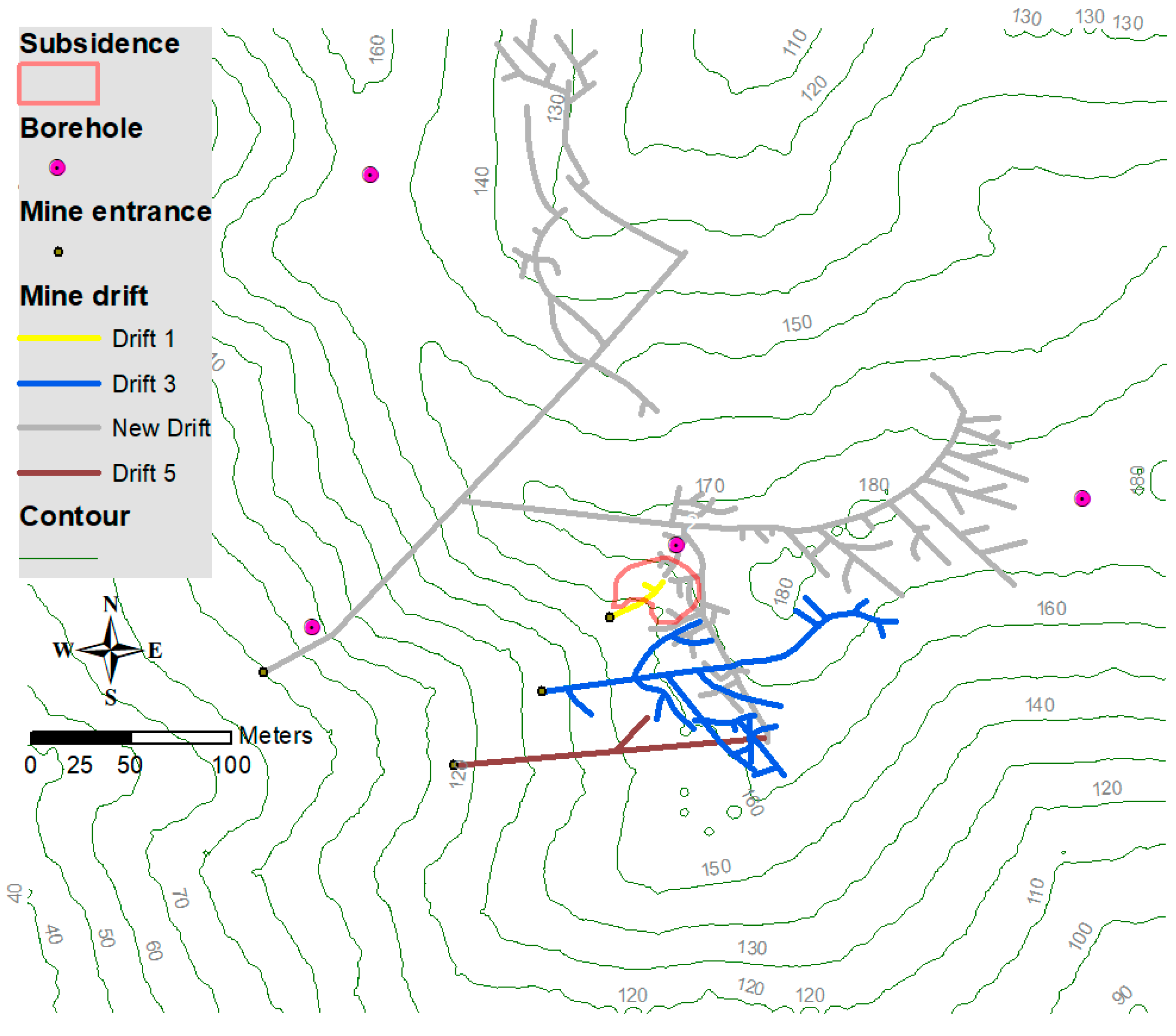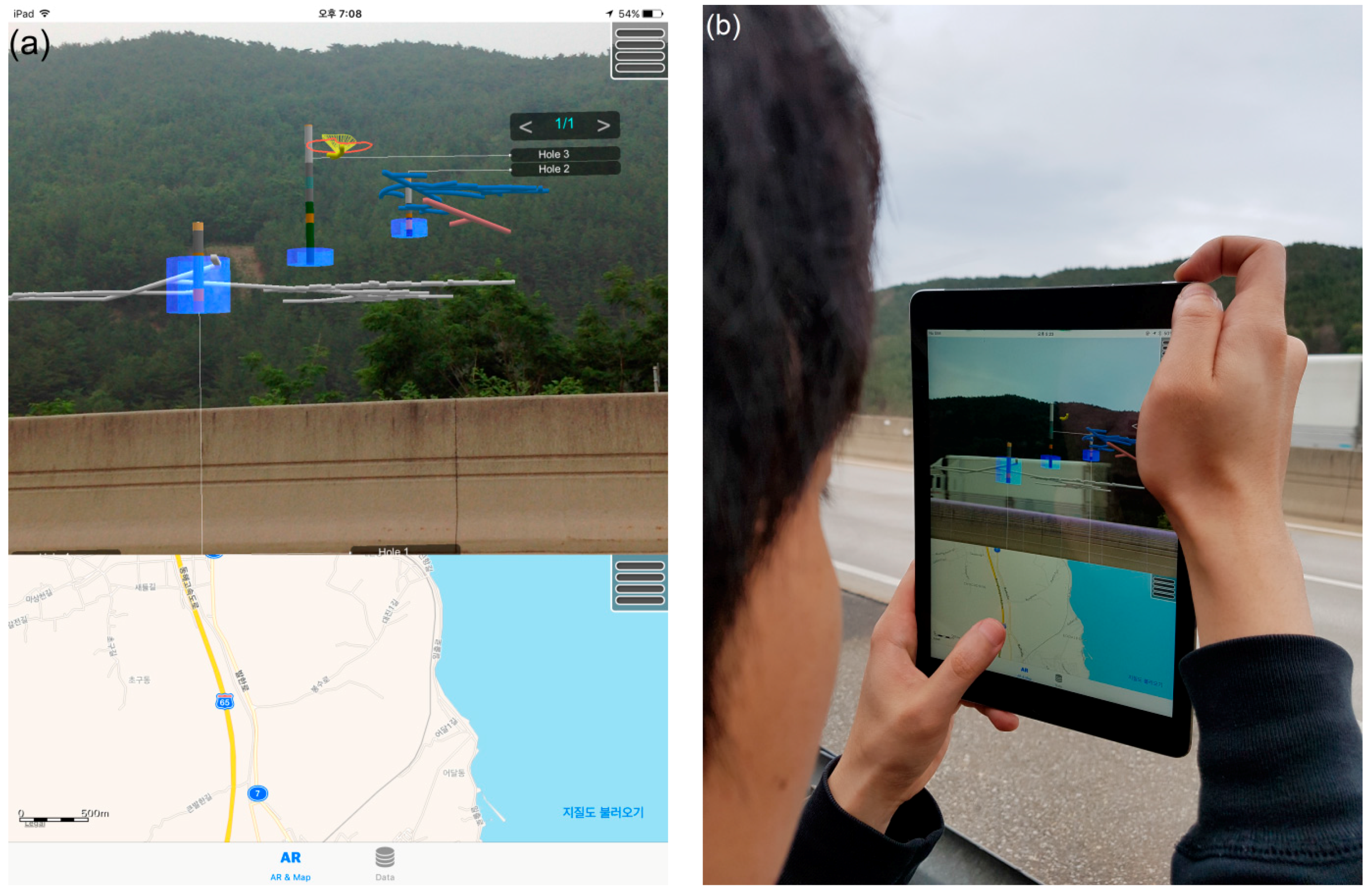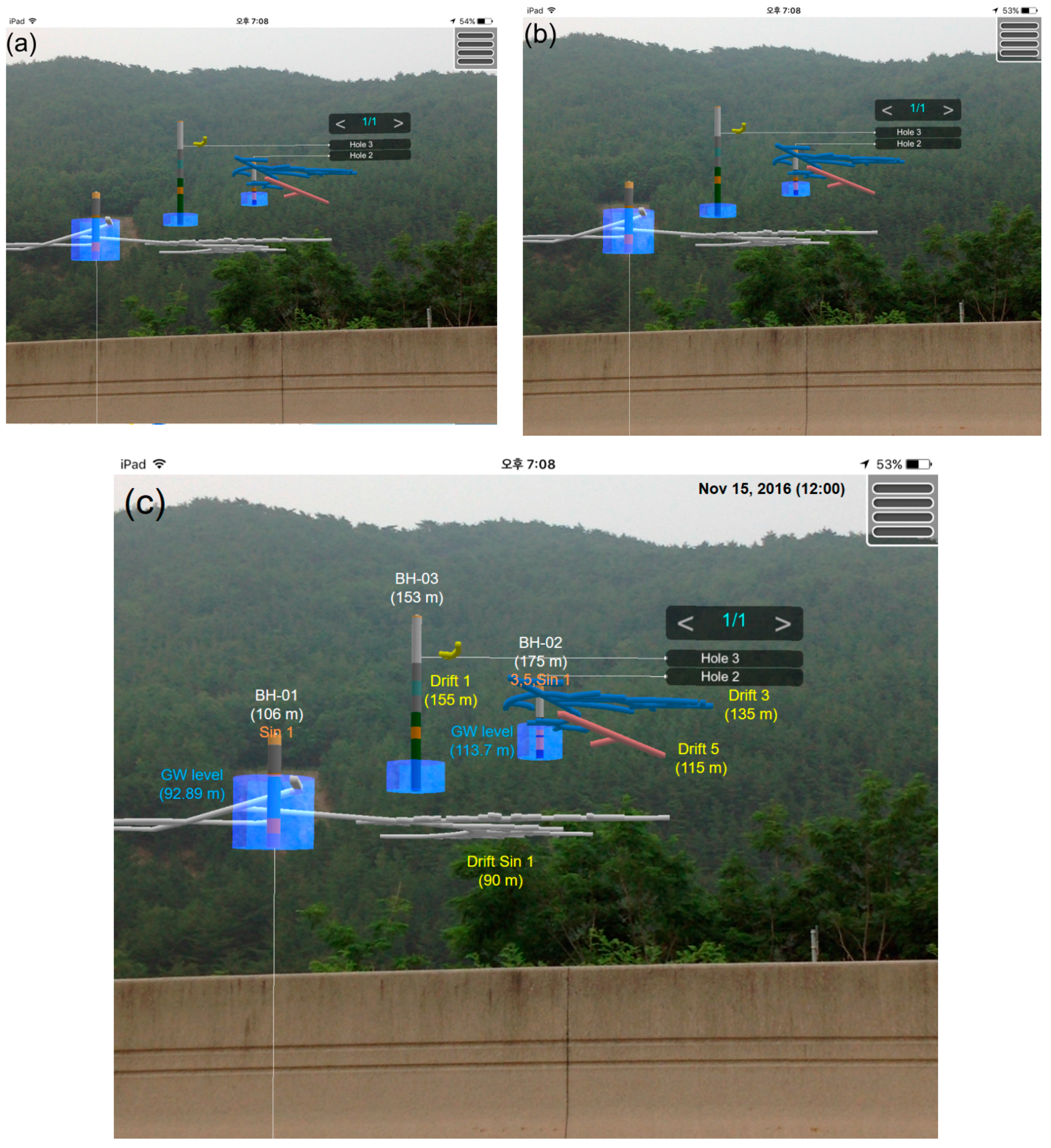4.1. Study Area
The Waryong coal mine, located at Donghae-Si, Ganwon-Do, South Korea, was selected as the study area for the UMineAR application.
Figure 3 shows the topography and distributions of mine drifts, boreholes, and zones of subsidence in the area. Underground coal mining was conducted in a wide area of the Waryong coal mine for nearly 25 years. The study area presents four mine drift groups with different levels and four mine entrances. All four mine openings were physically closed by collapse (
Table 4) since 1989. The mine was abandoned without implementation of appropriate mine reclamation measures, such as mine opening sealing for mine water leakage and underground cavity filling. Consequently, some subsidence events, including trough-type and sinkhole-type collapses, have been reported. Moreover, numerous water problems, such as inundation of the mine drift, groundwater rebound, and mine water leakage, occurred since 2010 from rainfall and nearby groundwater inflow. To prevent and manage the aforementioned mine water problems, several mine reclamation works were considered, such as mine opening sealing, water piping, and biochemical treatment. In addition, measurement sensors were installed in four boreholes for the long-term monitoring of the groundwater level fluctuation in the study area.
4.2. Results of Mine GIS Data Retrieval and Visualization Using UMineAR
UMineAR was tested near the Waryong coal mine (37°34′13″N and 129°06′07″E). UMineAR respectively equipped with an iPad Pro Wi-Fi only model (without cellular) as well as a Wi-Fi + cellular model were tested to examine the applicability of both models (because the Wi-Fi only model is more widely used). Regardless of the model used, iPad Pro could recognize the approximate location of the device using the inbuilt GPS-based position information. However, the positional accuracy of the iPad Pro Wi-Fi only model was lower (owing to the insufficient calibration of the coordinate because few repeaters existed near the region) compared with that of the Wi-Fi + cellular model. That is, a more exact 3D coordinate of the device, obtainable from other equipment (not from inbuilt GPS-based coordinate), was required when using UMineAR with the Wi-Fi only model. Accordingly, the exact latitude, longitude, and elevation of the device were obtained using the information from Garmin GPS equipment (Garmin, Olathe, KS, USA). Subsequently, the longitude and latitude of the device were inputted by activating the “virtual positioning” toggle, and the device elevation was set using the “viewer’s altitude” function (deactivated with the “use current alt” option) of the search option module (
Figure 2a). In the case of using UMineAR with the Wi-Fi + cellular model, the localization process was automatically performed by simply activating the “use current alt” toggle of the search option module. Therefore, the complex localization process could be omitted when using the Wi-Fi + cellular model.
The search radius was set to 500 m and the radius was increased up to 3000 m to retrieve mine drifts, groundwater level data, boreholes, and subsidences of the Waryong mine only (to exclude retrieval of the mine GIS database of the other mines). As a result, UMineAR searched for data on four mine drift groups (with different levels), four mine entrances corresponding to four mine drift groups, four boreholes with a temporal groundwater level, one subsidence, and one influential zone located within 3000 m of the user with the device.
Figure 4a shows the cross-sectional view screenshots that were obtained on the UMineAR system with the aforementioned settings at a latitude of 37°34′8.76″ and a longitude of 129°5′52.58″. The figure shows the existing mine GIS datasets (i.e., three of four mine drifts, mine entrances, three boreholes with groundwater levels, a subsidence, and an influential zone by specific mine drift) superimposed onto the view of the Waryong coal mine on the AR interface. It was determined that the retrieved datasets corresponded to those found in the MIRECO mine GIS database.
On any AR application, coordinate of objects were computed before each frames are displayed. The iPad or other similar smart devices display live video at 30 frames per second. It means that every calculation tasks for displaying a frame should be finished in less than 0.03 second to display the contents with minimum time lag. To enable fast drawing of 2D or 3D graphic elements, a hardware acceleration technique can be used. This technique utilizes a dedicated hardware for graphic processing so the CPU can have more time to process the internal features rather than calculating each pixel to display, which takes a considerable number of calculations.
The file size of the mine GIS data influenced the load time of data into the mobile system. On average, the size of the dataset for a single mine drift group was less than 3 MB, a single borehole with groundwater level and rock type data was approximately 1 MB, a subsidence was less than 0.1 MB, and an influential zone was less than 0.2 MB. Accordingly, the overall size of the mine GIS datasets of the Waryong coal mine accounted for less than 20 MB. The data loading time of cellular network environments (e.g., 3G networks) limits the download capability of the application if vast amounts of mine GIS datasets are retrieved or needed. However, the UMineAR system is suited for the use of retrieving and visualizing a single mine at a time. Therefore, the data searching and loading times for visualization would be not a problem in cellular network environments in practice.
Approximately 4 s was required to search and display the entire Waryong mine GIS dataset of approximately 20 MB, and 1.5 s to 2 s was needed to search and display an individual layer (i.e., a mine drift layer, mine entrance layer, borehole layer, or subsidence layer) in the 3000 m of search radius. Basically, the data search time was proportional to the number of retrieved mine GIS dataset items since a calculation of the relative coordinate was required for every mine GIS data item. If the number of target objects was small, most of the time consumed by UMineAR was dedicated to the searching options settings. In general, it is predicted that less than 10 s is required to download mine GIS dataset of 50 MB in 3G environment in South Korea. Three test subjects with more than five years of experience with 2D hardcopy mine maps required more than 10 min on average to identify the distributions of the mine drifts and determine the exact locations of the mine entrance, boreholes and subsidence in the field.
Although 2D hardcopy mine maps provide information on the distributions of mine drifts in either a lateral (cross-sectional) view or a plane view, it is difficult to interpret and understand the mine drift networks, which are intricately distributed (vertically overlapping and horizontally dense) in 3D in the real world. Moreover, without UMineAR, the investigators may require additional time and effort to find the target mine drifts, boreholes, and subsidence; moreover, a large amount of hardcopy data is needed for elucidating the spatio-temporal groundwater level changes (or fluctuation patterns). Generally, new investigators who are unfamiliar with the study area may have difficulty locating their positions during searches for mine drifts, boreholes, and subsidence. The time required for geolocating and subsurface interpretating will vary depending on the characteristics of each site. It is thus concluded that UMineAR enables elucidation of the subsurface geological characteristics in abandoned mine sites and significantly reduces the total investigation time and cost for mine site investigations.
4.3. Results of Groundwater Rebound Analysis by Applying UMineAR
The hourly measurement of groundwater levels of boreholes was conducted on 26 October 2016 (BH-01) and 15 November 2016 (BH-02, BH-03, and BH-04). Representative groundwater level data of four boreholes retrieved from the groundwater monitoring database are summarized in
Table 5. The difference between maximum and minimum values of the groundwater level of boreholes ranged from 1.2 m to 7.4 m. When the abandoned mine site received heavy rain, the groundwater levels of all four boreholes were generally high. However, as listed in
Table 5, the date with the maximum (or minimum) groundwater levels for the four boreholes may not have differed because the subsurface geological characteristics (e.g., fracture zone, permeability, and discontinuity) for the regions of each borehole were different.
The elevation of each mine drift was compared with the groundwater level of the borehole adjacent to the mine drift using UMineAR to identify whether each mine drift was submerged. Data on the minimum, current, and maximum values of the groundwater level of borehole No. 2 are visualized in
Figure 5. As shown in both
Figure 3a and
Figure 5c, BH-01 and BH-04 (unseen) are located near the new mine drift, and BH-02 is located in the vicinity of mine drift No. 3, No. 5, and new drift. In contrast, BH-03 is approximately 65 m horizontally from the nearest mine drift.
As shown in
Figure 5c, the groundwater level of BH-01 (in the translucent blue cylinder) was higher than that of the new mine drift. The minimum value of the groundwater level of BH-01 was 91.79 m (
Table 5), which exceeded the elevation of new mine drift (90 m) adjacent to BH-01. Thus, it is obvious that the new mine drift was submerged under 1 to 2 m of mine water, unless a large volume of inflow mine waters easily leak. This interpretation can be proved by the result of the mine water leakage investigation results in
Table 4.
The groundwater levels of BH-02 fluctuated between 108.72 m and 113.70 m for eight months of monitoring. Although the mean value of the groundwater level of BH-02 did not exceed the elevation of neighboring mine drift No. 3 or No. 5, the difference between the maximum groundwater level of BH-02 (113.70 m) and the elevation of mine drift No. 5 (115 m) was calculated as only 1.3 m.
Figure 5c also shows that the maximum groundwater level of BH-02 is similar to the elevation of mine drift No. 5. This indicates that mine drift No. 5 might be inundated when unexpected heavy rain occurs or when groundwater flows in the study area.
In the case of BH-04, the groundwater level exceeded 143 m. The inundation and mine water leakage of new mine drift was associated with this result. However, BH-04 was more than 100 m from the mine drift No. 3 or No. 5. Hence, it was difficult to analyze the association between the groundwater level of BH-04 and the possibility of inundation of mine drift No. 3.
When taking into account the overall results of changes in groundwater levels, the mine opening sealing for new mine drift (essentially) and No. 5 (conservative perspective) was needed to prevent and control the mine water leakages. Furthermore, continuous monitoring of the groundwater rebound of both boreholes and mine drifts, as well as mine water leakages though the mine entrances, was required.
